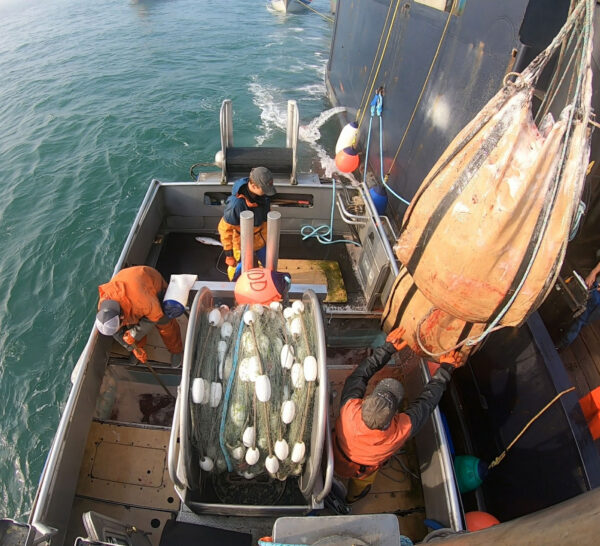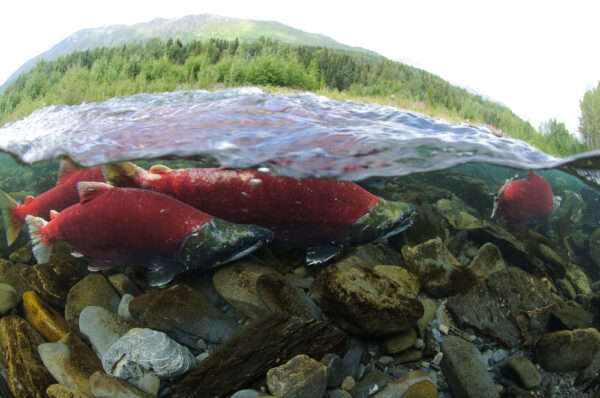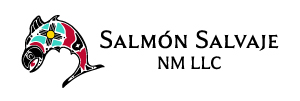Wild vs. Farm-Raised
What is the difference?
It is hard to know what drives people to seek out wild sockeye salmon: the taste and firm texture, the deep red color or the high omega-3 oil content. All contribute to sockeye being the premium Pacific salmon for the table. However, the choice between wild caught or farm raised salmon is more than taste, texture and color. There are environmental, sustainability and business reasons as well.
The dirtiest secret of farmed salmon is the huge number of wildfish harvested as a protein supplement for their feed. Consuming farmed salmon depletes wild fish stocks at an alarming rate, much more than consuming wild fish directly. So, if sustainability is a concern seek out wild salmon and avoid farmed salmon.
Unfortunately for U.S. consumers seafood fraud is high. The ocean advocacy group Oceana found that more than half the salmon it sampled from grocery stores and restaurants around the U.S. were incorrectly labeled. Most of the mislabeled salmon was farmed Atlantic salmon presented as wild caught.
“Americans might love salmon, but as our study reveals, they may be falling victim to a bait and switch,” said Beth Lowell, senior campaign director at Oceana.
“When consumers opt for wild-caught U.S. salmon, they don’t expect to get a farmed or lower-value product of questionable origins. This type of seafood fraud can have serious ecological and economic consequences. Not only are consumers getting ripped off, but responsible U.S. fishermen are being cheated when fraudulent products lower the price for their hard-won catch,” she adds. Oceana Reveals Mislabeling of America’s Favorite Fish: Salmon
The only way to fight fraud is for the supply chain to be transparent, which means openly tracking fish from fishing boat, to processor, to market. I and other Bristol Bay fishers catch sockeye during the summer fishing season that we bring to Silver Bay Seafood tender vessels that in turn bring this fish to the Silver Bay processing plant in Naknek, Alaska.
The fish is processed in Naknek, the fillets are frozen and packaged and loaded into containers that are shipped by barge down to Seattle where I pick up my portion of the catch. I then arrange for these fillets to be brought by truck to cold storage in New Mexico to be sold as Salmón Salvaje NM wild sockeye.
Wild
 The lifecycle of Salmón Salvaje NM wild sockeye start during the summer months in gravel beds of small freshwater streams that flow into Alaska’s Bristol Bay. After female sockeye lay their thousands of eggs in the gravel nests called redds, the infant fish, alevins, hatch two to three months after fertilization and remain close to their gravel nest living off their yoke sack over that first winter.
The lifecycle of Salmón Salvaje NM wild sockeye start during the summer months in gravel beds of small freshwater streams that flow into Alaska’s Bristol Bay. After female sockeye lay their thousands of eggs in the gravel nests called redds, the infant fish, alevins, hatch two to three months after fertilization and remain close to their gravel nest living off their yoke sack over that first winter.
In the spring the baby fish, now called fry, float down to a lake where they live for the next one to three years feeding on zooplankton and small crustaceans. When they decide to move on the sockeye migrate to the ocean in the spring as one to two-ounce smolts. They will spend two to three years in the ocean swimming thousands of miles before returning to the gravel beds of their birth to spawn.
Sockeye circle the ocean in the counter-clockwise current of the Alaska Gyre that extends 2,500 miles east and west along latitude 50 degrees north. The circular current extends from the coast of North America to the Kamchatka Peninsula in Russia.
As they grow sockeye strengthen muscles and eat krill and zooplankton to put on weight all in preparation for the journey back to the gravel beds of their birth. For many sockeye, the trip from ocean feeding grounds to fresh water gravel beds adds thousands of additional miles to their migrational journey. To make sure they have fuel for the swim sockeye pack on all that good omega-3 oil that makes them such a great nutritional choice.
The strength and food stores sockeye need to complete their arduous lifecycle imparts the dense texture, taste of wild sockeye.
Sustainability
 The strength of the Bristol Bay sockeye run may surprise those who think wild fish stocks are experiencing a precipitous downward trend. The Alaska Department of Fish and Game said this about the 2022 Bristol Bay sockeye season, “The 2022 inshore Bristol Bay sockeye salmon run of 79.0 million fish is the largest inshore run on record and was 81% above the 43.6 million average run for the latest 20-year period (2002–2021). Additionally, it was just the fourth time on record that the Bristol Bay inshore sockeye salmon run has exceeded 60.0 million fish.”
The strength of the Bristol Bay sockeye run may surprise those who think wild fish stocks are experiencing a precipitous downward trend. The Alaska Department of Fish and Game said this about the 2022 Bristol Bay sockeye season, “The 2022 inshore Bristol Bay sockeye salmon run of 79.0 million fish is the largest inshore run on record and was 81% above the 43.6 million average run for the latest 20-year period (2002–2021). Additionally, it was just the fourth time on record that the Bristol Bay inshore sockeye salmon run has exceeded 60.0 million fish.”
“The commercial harvest of 60.1 million sockeye salmon is the largest harvest on record, surpassing the previous record set in 1995 of 44.3 million sockeye salmon by 36%. All sockeye salmon escapement goals were met or exceeded, with a total bay-wide escapement of 18.9 million fish.” —2022 Bristol Bay Salmon Season Summary
That last sentence is telling: The 2021 harvest of 40.4 million sockeye was 44% higher than the recent 20-year average, the 2022 harvest of 60.1 million sockeye was 104% higher than the recent 20-year average. Bristol Bay’s sockeye run is the largest run of sockeye in the world and it has been growing strongly over the past ten years. The run in not only sustainable but it appears to be growing.
More generally, while wild fish stocks are feeling the impact of over fishing and climate change, the situation is species dependent with some species like Bristol Bay sockeye making gains and others declining. According to the UN’s biannual 2020 The State of World Fisheries and Aquaculture report, as of 2018 wild caught fish accounted for 96 million tons of the world fish consumption, while fish farms and aquaculture provided 82 million tons. The harvest of wild fish, a 10 percent increase from 1996, still accounts for the bulk of seafood supplied to world markets and while the species makeup has changed, the volume of the wild fish harvest is increasing according to the report.
There are a variety of reasons the Bristol Bay sockeye run remains robust, but chief among them are a sockeye’s lifecycle which allows biologists a first hand view of the health of fish populations enabling them to instate good management strategies.
The vast undeveloped wilderness of the Bristol Bay watershed gives sockeye a pristine environment for reproduction untouched by human development. The proposed Pebble Mine threatens this pristine environment and the future of the run will be in jeopardy if mine development goes further.
Environmental Impact
 Salmon falsify the belief that everything flows down hill to the ocean. Salmon carry the oceans bounty of years of eating in the open water deep into forests where flora and fauna reap benefits.
Salmon falsify the belief that everything flows down hill to the ocean. Salmon carry the oceans bounty of years of eating in the open water deep into forests where flora and fauna reap benefits.
“When they return to spawn, salmon become a veritable conveyor belt for nutrients. For example, an adult chum salmon returning to spawn contains an average of 130 grams of nitrogen, 20 grams of phosphorus and more than 20,000 kilojoules of energy in the form of protein and fat; a 250-meter reach of salmon stream in southeast Alaska receives more than 80 kilograms of nitrogen and 11 kilograms of phosphorous in the form of chum salmon tissue in just over one month.” Why Fish Need Trees and Trees Need Fish
Stream side vegetation and trees grow much faster along salmon spawning beds than streams without salmon. Some estimate Sitka spruce along salmon streams grow three times faster than trees along streams without salmon. Fauna also benefit from wild salmon returning to spawn. Alaska brown bears were once considered a different species from other North American brown bears because they were so much larger. But it turned out their great size was due to salmon consumption rather than genetic difference. It is not just the bears who benefit, spawned out salmon provide a rich diet to insects, birds and other animals who spread salmon nutrients further inland on their journeys.
The wild ecosystem of Alaska’s interior depends on the nutritional boost that the returning spawning salmon bring, a symbiotic relationship developed over 100,000s of years. The life, death and decomposition of wild salmon are something the forests cannot live without.
Wild Product, Natural Ingredients
 Wild sockeye consumes most of its food in the wide open water of the northern Pacific, a long way from human caused pollution that concentrates along ocean shores. Wild salmon eat at their own pace and their weight gain happens naturally.
Wild sockeye consumes most of its food in the wide open water of the northern Pacific, a long way from human caused pollution that concentrates along ocean shores. Wild salmon eat at their own pace and their weight gain happens naturally.
Large production salmon farms have feeding and weight gain expectations geared to maximize growth so salmon are quick to market. This accelerated growth requires high-calorie food. As a result, farmed salmon have more calories than wild salmon due to their elevated fat and saturated fat levels.
Farmed fish are also genetically similar and raised close together so antibiotics are needed to keep farm populations healthy. Pesticides are used to resist the growth of parasites like sea lice. You are not going to find neither antibiotics nor pesticides in wild salmon.
Sockeye is low in mercury compared to other wild caught fish like marlin, tuna, shark, swordfish, Chilean sea bass and mackerel. The main reasons for low mercury is that the sockeye eat zooplankton, krill and other small organisms that are at the bottom of the food chain. These species have little mercury themselves. Sockeye also spend their life thousands of miles from human industrial pollution. Finally, mercury accumulates as a fish ages, and sockeye, with their relatively short life of 4 to 5 years, has little opportunity for mercury to build up.
Family Business versus Corporate
About 1,500 boats participate in the Bristol Bay salmon fishery, each a small family business working to catch as many salmon as can be landed during the short summer season.
Daughters and sons fish alongside moms and dads on many boats, or family members run their own boats. At one time in my fishing career I fished along side two uncles, two cousins and worked with sisters and cousins on my boat.
All Bristol Bay boats are limited to 32-feet in length, a regulation meant to keep the fishery affordable. These boats deliver catches to a variety of processing companies, some large multi-national food companies and some smaller Alaskan companies in which fishers own a share of the company.
All Salmón Salvaje NM salmon comes from the largest fisher owned company in Bristol Bay, Silver Bay Seafoods. A little over 100 boats sell to Silver Bay, and some of those fishers, like me, are picking up Silver Bay fillets in Seattle to sell on to you. It’s a boat to table model along the lines of your local CSAs (Community Supported Agriculture).

Farm Raised

Photo by Gordon Legget
The difference between Salmón Salvaje NM sockeye and farmed salmon is more than texture and taste. Farmed salmon is Atlantic salmon, a different species. Furthermore, circling a pen in coastal waters will never give farmed salmon the firm texture that wild salmon gain by swimming thousands of miles during their years of migration. Farmed fish are fed a rich diet to promote growth, there by speeding their way to the market. Couple this rich feed with little exercise and it’s not surprising to learn that farmed salmon has over 40 percent more calories than wild sockeye.
There is a misconception that eating farmed salmon takes pressure off wild salmon stocks thereby helping their recovery. As noted above, Bristol Bay’s sockeye run is the highest it has ever been; the run is thriving with no need for recovery.
More to the point, consuming farmed salmon puts pressure on wild fish stocks which are used for the “fish oil” and “fishmeal” protein supplement farmed salmon are fed. Fish farming is consuming so many wild fish for their feed that it is imperiling the survival of the wild fish harvested for this use. Eating farmed fish actually increases pressure on wild fish stocks, the opposite of what most people think.
In David Willer and colleagues March 2022 article “Maximizing sustainable nutrient production from coupled fisheries-aquaculture systems” they note that “production of the 179,000 tonnes of Scottish Atlantic salmon in 2014 required fish oil derived from 460,000 tonnes of wild-caught fish, 76% of which were species edible by humans.” So, that one-pound farmed fish fillet you buy in the store includes 2.5 pounds of wild fish caught and ground up for its food to be ready for market.
This clearly is not an efficient use of the world’s resources, is it? How is the production and consumption of farmed salmon sustainable? Willer argues it is not, and notes that phasing out salmon farming would allow more wild fish to reach the market.
Wild sockeye eat zooplankton, krill and small fish whereas farmed salmon eat artificial feed fortified with fish oil, fish meal, vitamins, minerals, pigments and amino acids. The antioxidant astaxanthin is added to salmon feed to boost the fish’s immune system and to protect their tissue. What Does Salmon Feed Contain
Fish waste from farming operations has caused so much coastal pollution, and become so unsustainable, that many nations are updating regulations to try and get out in front of the problem. Unfortunately, there appears little effort to clean up waste left from farming pens; the solution is to move pens to unpolluted areas and start again.
Like all industrial level animal production, the fish have shared genetics which leaves them susceptible to disease and parasites in the small, enclosed pens in which they are raised. Fish feed delivers the antibiotics to help fight disease and pesticides are used to deal with parasites like sea lice, which are particularly aggressive towards salmon. Both can end up in trace amounts in farmed salmon fillets.
Unlike the small family boats that harvest wild Bristol Bay salmon, the salmon farming industry is dominated by a handful of multinational corporations including Marine Harvest, Lerøy Seafood Group, Cooke Aquaculture, Empresas AquaChile, Cermaq and others.
Unfortunately, as I mentioned above, the ocean advocacy group Oceana found that farmed salmon is frequently mislabeled as “wild”. This is misleading and confusing, making it difficult for consumers when they are choosing to buy actual wild sockeye.
